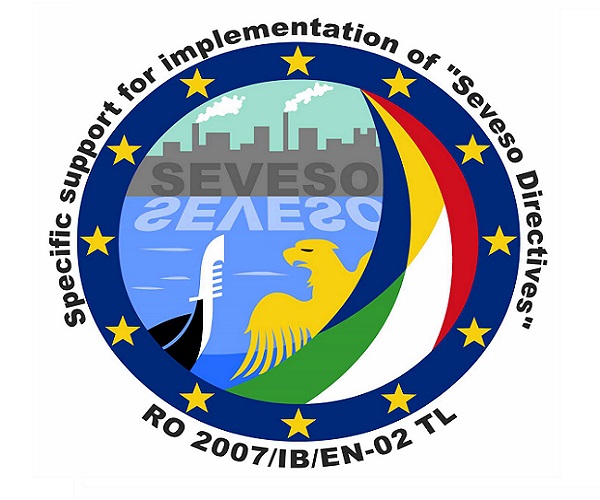PHARE TWINNING RO2007/IB/EN 02/TL- Implementation of Seveso Directives
Country: Romania
Duration: May 2009 – February 2010
Budget Project: € 242.000,00
Beneficiary Country: Romania, Ministry of Interior and Administrative Reform, together with the General Inspectorate for Emergency Situations and administrative bodies at local and regional levels responsible for management of emergency situations.
Overall Objectives: To improve the implementation of land use planning, safety management systems, inspection – checking of implementation/prohibition of use, assessment of risk analysis and major accidents/incidents investigation, by assisting Romania in achieving an effective implementation and enforcement of the requirements of Directive 96/82/EC (Seveso II) and 2003/105/EC Directive by improving administrative framework and institutional capacities as well as to support the operators of Seveso establishments in development of an effective safety management system.
Project purpose: Enhancing the administrative and control capacities of the relevant Romanian authorities regarding the implementation and enforcement of SEVESO II Directives on control of major-accident hazards involving dangerous substances, including its amendment directive.
This has been achieved through training activities (workshops, hands-on and pilot exercises, guidance notes and support documentation) and by developing methodologies, guidelines and checklists in order to fulfill the core requirements of the Directive, to be further used by the relevant authorities for evaluation of the documentation drawn up by operators, organization and development of inspections on SEVESO sites, evaluation of major accidents effects and land use planning around Seveso sites.
Results:
• The methodology for land use planning in the context of SEVESO II Directive requirements elaborated and disseminated to the national/local competent authorities. The methodology was approved by a common order of the Minister of the Ministry of Interior and Administrative Reform and Minister of the Ministry of Environment and Sustainable Development.
• Guidelines for elaboration and evaluation of Safety Management System elaborated and disseminated to the local competent authorities and operators. The guidelines were elaborated as a guide to be used for inspection and evaluation of the Seveso sites process and for the elaboration of specific documentation.
• Specific check lists for inspection of refineries, Liquefied Petroleum Gas factories, fertilizer establishments and mining activities falling under Seveso II Directive requirements developed and disseminated to the local competent authorities. The check lists were elaborated as a guide to be used in the inspection and evaluation of the Seveso sites process.
• Guidelines on evaluation of Safety Reports, Major-Accident Prevention Policy and Emergency Plans elaborated and disseminated to the national/local competent authorities;
• Staff from the General Inspectorate for Emergency Situations and County Inspectorates for Emergency Situations trained during 3 train of trainers seminars on land use planning in the context of Seveso framework, evaluation of Safety Management System, inspection of refineries, Liquefied Petroleum Gas factories, fertilizer establishments and mining activities falling under Seveso II Directive requirements, evaluation of Safety Reports, Major-Accident Prevention Policy and Emergency Plans and on major accident investigation procedure,
• Staff from national/local competent authorities further trained by the trainers on land use planning in the context of Seveso framework, evaluation of Safety Management System, inspection of refineries, Liquefied Petroleum Gas factories, fertilizer establishments and mining activities falling under Seveso II Directive requirements, evaluation of Safety Reports, Major-Accident Prevention Policy and Emergency Plans and on major accident investigation procedure.
• Staff from the General Inspectorate for Emergency Situations and County Inspectorates for Emergency Situations trained during 1 train of trainers’ seminar in using the most appropriate software for industrial risk assessment on SEVESO II Directive. The trainers shall further train and provide assistance to the specialists from national/local competent authorities.
Activities:
A) To provide assistance for drawing up a land use planning methodology in conformity with Seveso II Directive requirements:
– Presentation of the European Union/Member State experience in the field of land use planning from the national competent authorities: General Inspectorate for Emergency Situations, National Environment Guard, National Agency for Environment Protection;
– Elaboration of the methodology for land use planning in the context of SEVESO II Directive requirements;
– Train the trainers seminar (TOT) on the application of the methodology for land use planning in the context of SEVESO II Directive requirements.
B) To provide assistance for elaboration of Safety Management System and documentation evaluation guidelines:
– Presentation of the European Union/Member State experience in the field of industrial safety and risk management;
– Elaboration of the guidelines for Safety Management System and documentation assessment;
– Train the trainers seminar (TOT) on application of the Safety Management System and documentation evaluation guidelines.
C) Defining the specific check lists for inspection of refineries, Liquefied Petroleum Gas factories, fertilizer establishments and mining activities falling under Seveso II Directive requirements:
– Presentation of the European Union / Member State experience in the field of Seveso II establishments inspection;
– Elaboration of detailed check lists for refineries, Liquefied Petroleum Gas factories, fertilizer establishments and mining activities;
– Train the trainers seminar (TOT) on application of detailed check lists for refineries, Liquefied Petroleum Gas factories, fertilizer establishments and mining activities.
D) Exchange of experience in the practical field:
– Study visit in Member State;
– Exchange of experience in Romania
E) Train the trainers seminar for assessment of the existing software at European Union level (Member State) and training using the most appropriate software for industrial risk assessment on SEVESO II Directive.




